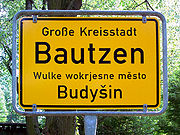Upper Sorbian language
| Upper Sorbian | ||
|---|---|---|
| Hornjoserbšćina | ||
| Pronunciation | [ˈhɔrnjɔˌsɛrbʃtʃina] | |
| Spoken in | ||
| Region | Saxony, Brandenburg | |
| Total speakers | 40,000 | |
| Language family | Indo-European
|
|
| Writing system | Latin (Sorbian variant) | |
| Official status | ||
| Official language in | regional language in Germany (Brandenburg and Saxony) | |
| Regulated by | No official regulation | |
| Language codes | ||
| ISO 639-1 | None | |
| ISO 639-2 | hsb | |
| ISO 639-3 | hsb | |
| Linguasphere | ||
| Note: This page may contain IPA phonetic symbols in Unicode. | ||
Upper Sorbian (Hornjoserbšćina) is a minority language spoken in Germany in the historical province of Upper Lusatia (Hornja Łužica in Sorbian), which is today part of Saxony. It is grouped in the West Slavic language branch together with Lower Sorbian, Czech, Polish, Slovak and other languages.
Contents |
History
The history of the Upper Sorbian language in Germany began with the Slavic migrations during the 6th Century AD. Beginning in the 12th Century, there was a massive influx of rural Germanic settlers from Flanders, Saxony, Thuringia and Franconia. The succeeding devastation of the country by military actions began the slow decrease of the Upper Sorbian language. In addition, in the Saxony region, the Sorbian language was legally subordinated to the German language. Language prohibitions were later added: In 1293, the Sorbian language was forbidden in Berne castle before the courts; in 1327 it was forbidden in Zwickau and Leipzig, and from 1424 on it was forbidden in Meissen. Further, there was the condition in many guilds of the cities of the area to accept only members of German-language origin.
However, the central areas of the Milzener and Lusitzer, in the area of the today's Lausitz, were relatively unaffected by the new German language settlements and legal restrictions. The language therefore flourished there. By the 17th Century, the number of Upper Sorbian speakers in that area grew to over 300,000. The oldest evidence of written Upper Sorbian is the „Burger Eydt Wendisch” monument, which was discovered in the city of Bautzen and dated to the year 1532.
The Upper Sorbian language in Germany

There are estimated to be 40,000 speakers of Upper Sorbian, of which almost all live in Saxony. This puts Upper Sorbian as the third largest minority language in Germany, after Turkish and Danish, but before Frisian. Since the nationality affiliations in Germany are not officially recorded and Upper Sorbian nationality is self-identified, these figures are only estimates. The number of active speakers may be substantially smaller. Some scholars predict that Upper Sorbian is in danger of extinction. Computer forecasts predict that in 20-30 years time, there will only be 7,000 speakers of Lower Sorbian and 13,000 of Upper Sorbian left in the world. (Some in fact believe that Lower Sorbian may be extinct by that time.) In the opinion of more optimistic language experts, by the end of the 21st century Upper Sorbian will not yet be extinct. Nevertheless, no further reliable forecasts can be made at the present time.
See also
- Sorbian alphabet
- Lower Sorbian language
External links
Dictionaries
- (German)(Upper Sorbian)Hornjoserbski dictionary
- (German)(Upper Sorbian)SorbWord
- (German)(Upper Sorbian)Sorbian 'language practice' page Leipzig University's
- (German)(Upper Sorbian)Sorbian information page Leipzig University's
- (German)(Upper Sorbian)Wortschatz.de
Deutsch-Serbski
- (German)(Upper Sorbian)at sibz.whyi.org
- (German)(Upper Sorbian)at Böhmak.de
Serbski-Deutsch
- (German)(Upper Sorbian)at Böhmak.de
- (German)(Upper Sorbian)at sibz.whyi.org
|
||||||||||||||||||||